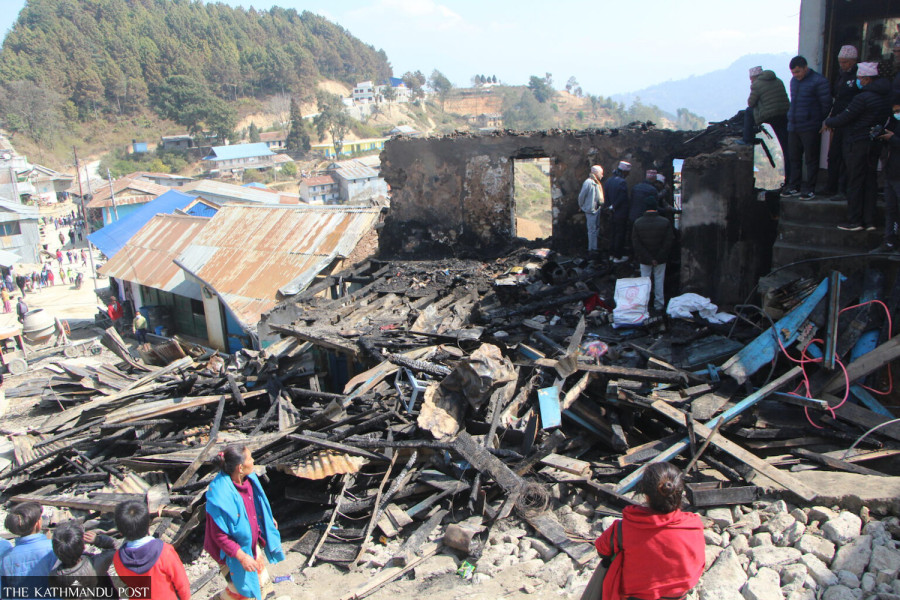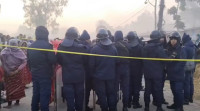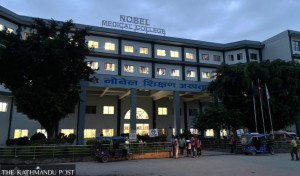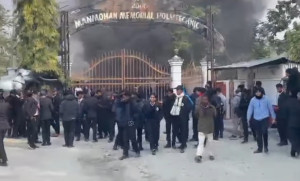Koshi Province
Province 1 districts ill-prepared for fire disasters
Every year, properties worth millions are destroyed in fire incidents in Taplejung and Panchthar but authorities have no plans to control them.
Ananda Gautam & Laxmi Gautam
Forest fires and fire incidents in Taplejung and Panchthar districts of Province 1 lead to loss of forest cover, properties and human lives every year during the dry windy season. This year too both the districts have reported several fire incidents in human settlements and community forest areas but the concerned authorities have so far been unable to prevent such incidents.
A forest fire in the Amjilesa area of Kanchenjunga Conservation Area that started on March 10 is yet to be brought under control. The fire destroyed one of the four houses in Lelep settlement of Phaktanglung Rural Municipality-6 on March 11.
According to Fupu Sherpa, a resident of Phaktanglung Rural Municipality-6, the fire had started as a small blaze but it has now spread to the forest area.
The onset of the dry season has brought heavy winds to the region, causing forest fires to spread further. This has made it difficult for the locals and the authorities to douse them.
“Only rain can stop the fire from spreading. The locals haven’t been successful in dousing the forest fire so far,” said Sherpa.
Forest fires have been reported in Kharkling Katike Satpakha Community Forest in Makwakhola Rural Municipality-1 as well since March 13.
According to Community Forest Chairman Shriprasad Ghimire, efforts are being made to divert the fire away from human settlements.
Meanwhile, the Division Forest Office says it has not received the report of a fire outbreak in the Kanchenjunga Conservation Area.
“We know about forest fires spreading in the Khokling area. The Office has no information about the fire in the Kanchenjunga Conservation Area,” said Lalit Kumar Yadav, assistant forest officer of the Division Forest Office, Taplejung.
According to the data of the Division Forest Office, forest fires ravaged 116 hectares of land in Simbu and Sunpati community forests of Pathibhara area in the last year while forest fires in Triveni and Khaireni community forests of Pathibhara Yangbarak raged on in 44 hectares of land.
According to Yadav, many forest fires start due to human negligence. Sixty percent of forest fire is intentionally set by people while the remaining 40 percent are a result of natural causes.
According to Khagendra Phembu Limbu, chairman of the Kanchenjunga Conservation Area Management Council, every year, action is taken against those who set fire in the forest area. However, they have not been able to control the yearly outbreak of forest fires.
“The conservation area started taking preventive measures before the onset of the dry season by drawing fire diverting lines, alerting the community and forming fire control teams. The Division Forest Office has stated that it is working to raise public awareness among the community forest users,” said Yadav.
Krishna Ojha, central member of Community Forest Users Group, says controlling forest fires has become challenging since natural water sources have been drying up gradually.
“Earlier the rivers and rivulets had water flowing throughout the year and forest fires would die once they reached water bodies. But of late, all the natural water sources have dried up. There is no stopping the forest fires now,” said Ojha.
In Panchthar on the evening of March 10, a fire broke out in a three-storey house belonging to Om Bahadur Budhathoki in Kummayak Rural Municipality-1. By the time the villagers gathered around to douse the fire, it had gone out of control. The house burnt to a cinder in no time.
A fire broke out at Jharendra Khatiwada’s shop in Kummayak on January 17. Khatiwada and his neighbours reached the incident site but could not save the shop from burning down. A local entrepreneur of Yasok Bazaar, Khatiwada lost properties worth approximately Rs19 million.
On January 13, a massive fire broke out at Barbhanjyang in Phalelung Rural Municipality-6 destroying five houses and eight shops. Properties worth around Rs60 million were destroyed in the conflagration.
Fire incidents destroy properties worth millions every year in Panchthar but the concerned government authorities and the local units have not done anything to control such recurring disasters.
Stakeholders have complained that all three levels of government—federal, provincial and local—have failed to come up with any disaster preparedness plan.
A natural disaster management committee has been formed under the leadership of the chief district officer at the district level and a similar committee functions in each local unit to control various natural disasters, including fire. But the members of the committees admit that their efforts to control fire incidents have so far been ineffective due to a lack of necessary trained human resources and equipment.
“We don’t have the infrastructure to support disaster management. When a fire breaks out in settlements with wooden houses, it becomes difficult to control the fire. And the fire engines cannot reach remote settlements on time given the narrow lanes,” said Suresh Neupane, the chief district officer of Panchthar. “Fire incidents cause huge losses in the district every year.”
Negligence of the people is another leading cause behind the high number of fire incidents in the district. The locals sometimes light fires in the forest to clean a patch for better grass growth or to chase away wild animals. But these fires often enter human settlements and destroy lives and properties, according to Deputy Superintendent of Police Rakesh Thapa.
“Most of the forest fires are caused deliberately by humans in the winter season. The villagers inform the police about the fire only after it goes beyond control,” said Thapa.
Two years ago, a forest fire entered a settlement at Hilihang Rural Municipality-3 and destroyed seven houses. A year before that, in ward 7 of the same local unit, a villager was burnt to death as he attempted to control a forest fire from entering his settlement.
Most of the houses in rural settlements of the hill districts are made of wood and zinc sheet. The farmers and traders store cash crops like large cardamom and dried broom, which are highly flammable, in their houses, which makes a fire spread faster.
There are eight local units in Panchthar district. Only Phidim Municipality in the district has two fire engines but it does not have trained human resources to operate the fire brigades.
“One fire engine is kept at the District Police Office. The security personnel use it when required. The other fire engine is for our use but we do not have trained human resources to operate it. We deploy the municipal police and other available employees during fire incidents,” said Prakash Gurung, the ward chairman of Phidim-4.
The other seven local units in the district do not have plans to purchase or operate fire engines citing a lack of budget and high operation costs.
“Only one to two fire incidents occur in the local body a year. The purchase and operation of fire engines are expensive,” said Homnath Thapa, the chairman of Tumbewa Rural Municipality. “Many settlements are still not connected with the national road networks. So we have prioritised other infrastructure development projects, like building roads, instead of purchasing fire engines.”
Krishna Baskota, the chairman of the Panchthar branch of Nepal Red Cross Society, calls for the local bodies and other concerned authorities to prepare a collective work plan for disaster preparedness in the district.




 6.73°C Kathmandu
6.73°C Kathmandu
















